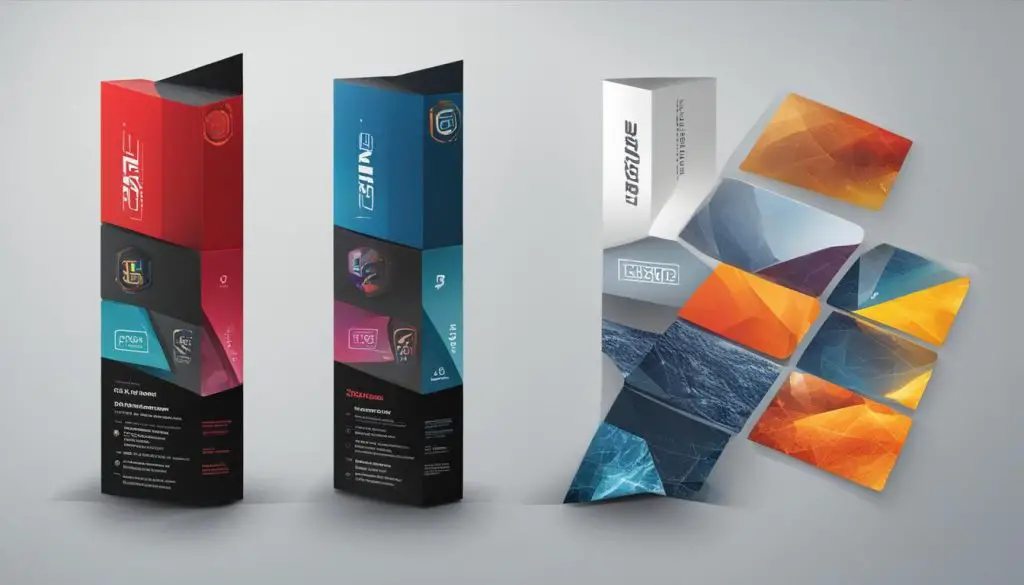EPS and PSD files are both commonly used file formats in the world of graphic design and image editing. However, they have distinct differences that set them apart. Understanding these differences can help you choose the right file format for your specific project.

EPS (Encapsulated PostScript) files are primarily used for printing and contain vector-based graphics. They are created and edited in design programs like Adobe Illustrator. On the other hand, PSD (Photoshop Document) files are created, edited, and saved in Adobe Photoshop and are mainly used for photo editing and manipulation. PSD files can contain both raster and vector graphics.
While both EPS and PSD files can be converted to different formats, EPS files can be saved as JPG, PNG, TIFF, and PDF files, while PSD files can be saved as JPG, PNG, and TIFF files.
Key Takeaways:
- EPS files are primarily used for printing and contain vector-based graphics.
- PSD files are used for photo editing and manipulation and can contain both raster and vector graphics.
- EPS files can be converted to formats like JPG, PNG, TIFF, and PDF.
- PSD files can be saved as JPG, PNG, and TIFF files.
- Understanding the characteristics and intended use of each file format is essential for choosing the right one for your project.
Difference between EPS and PSD Files
EPS (Encapsulated PostScript) and PSD (Photoshop Document) are two commonly used file formats in the world of graphic design and image editing. While they serve similar purposes, it’s important to understand their differences and how they are used in different software.
EPS files are primarily used for printing purposes and are widely requested by professional printers. They contain vector-based graphics and can be easily imported into design software like Adobe Illustrator. EPS files are compatible with PostScript printers and imagesetters, making them ideal for high-resolution prints of illustrations and logos. They offer scalability without loss of quality, allowing for precise and detailed prints.
On the other hand, PSD files are created, edited, and saved in Adobe Photoshop. They are primarily used for photo editing and manipulation. Unlike EPS files, PSD files can contain both raster and vector elements, making them versatile for complex editing tasks. With PSD files, designers have access to multiple layers, effects, and adjustments, allowing for intricate and creative designs.
It’s important to note that while EPS files can be converted to other formats like JPG, PNG, TIFF, and PDF, PSD files can also be saved in various formats such as JPG and PNG. However, PSD files may not be as widely supported by non-Adobe software and can be larger in size compared to EPS files.
| EPS Files | PSD Files |
|---|---|
| Primarily used for printing | Used for photo editing and manipulation |
| Contain vector-based graphics | Can contain raster and vector elements |
| Compatible with PostScript printers and imagesetters | Created, edited, and saved in Adobe Photoshop |
| Ideal for high-resolution prints of illustrations and logos | Offers layers, effects, and adjustments for intricate editing |
| Can be converted to other formats like JPG, PNG, TIFF, and PDF | Can be saved in various formats including JPG and PNG |
In summary, EPS and PSD files have distinct differences in their intended use and the software they are created and edited in. EPS files are primarily used for printing and contain vector-based graphics, while PSD files are used for photo editing and manipulation and can contain both raster and vector elements. Understanding these differences can help you choose the right file format for your specific project and ensure compatibility with the software you are working with.
EPS and PSD File Characteristics
When comparing EPS and PSD files, it is important to understand the characteristics and similarities between the two file formats. While they have distinct differences, they also share some key features that make them valuable in the world of graphic design and image editing.
Common Features
Both EPS and PSD files support transparency, allowing for a transparent background in the final output. This feature is particularly useful when incorporating graphics or images into different contexts or designs. Additionally, both file formats allow for the inclusion of fonts, colors, and other design elements, providing flexibility and creativity in the design process.
Another important characteristic of EPS and PSD files is their ability to be resized without loss of quality. This scalability feature enables designers to use the same file for various purposes, such as resizing a logo for different marketing materials or adjusting the dimensions of an image for different platforms.
Differences in File Composition
While EPS and PSD files do share similarities, they differ in terms of their composition and intended use. EPS files are primarily vector-based, which means they consist of mathematical formulas that define shapes and lines. This makes EPS files ideal for logos, typography, and simple graphics that require scalability and precision.
On the other hand, PSD files can contain both raster and vector elements. Raster images are composed of pixels and are best suited for complex photo editing and design projects, as they can capture fine details and variations in color and tone. PSD files, created and edited in Adobe Photoshop, offer extensive editing capabilities, including the use of layers, effects, and adjustments, making them versatile for intricate editing.

Summary
In summary, EPS and PSD files have their own unique characteristics and intended uses. While EPS files are primarily used for printing and are vector-based, PSD files are used for photo editing and manipulation and can contain both raster and vector elements. Understanding the similarities and differences between these file formats can help designers choose the most appropriate format for their specific project requirements.
Pros and Cons of EPS and PSD Files
When comparing EPS and PSD files, it is important to consider the advantages and disadvantages that each format offers. Understanding these factors can help you determine which file type is best suited for your specific needs and requirements.
EPS File Pros
- EPS files are excellent for high-resolution printing of illustrations and graphics.
- They can be easily imported into design software and are compatible with PostScript printers.
- EPS files allow for scalability without any loss of quality.
- They support transparency, making them ideal for designs with a transparent background.
EPS File Cons
- EPS files may not be as widely supported by non-design software.
- They can be converted to other file formats for versatility, but this extra step may be required.
PSD File Pros
- PSD files offer extensive editing capabilities, including layers, effects, and adjustments.
- They are widely used in the graphic design industry for photo editing and manipulation.
- PSD files can contain both raster and vector elements, providing versatility for complex projects.
- They can be saved in various formats, such as JPG and PNG, for easy sharing and use in different software.
PSD File Cons
- PSD files can be larger in size compared to other file formats.
- They may not be easily opened or edited in non-Adobe software.
Each file format has its own strengths and weaknesses, and choosing between EPS and PSD files depends on your specific project requirements. If you need high-quality prints or deal primarily with illustrations, EPS files may be the way to go. On the other hand, if you require extensive editing capabilities and work with complex designs, PSD files offer more flexibility. Consider the pros and cons outlined above to make an informed decision and ensure optimal results for your graphic design and image editing projects.
| EPS Files | PSD Files |
|---|---|
| Best for high-resolution printing | Primarily used for photo editing and manipulation |
| Vector-based graphics | Can contain both raster and vector elements |
| Compatible with PostScript printers | Extensive editing capabilities, including layers and effects |
| Supports transparency | Can be saved in different file formats |
| May not be widely supported by non-design software | Larger file sizes and limited compatibility with non-Adobe software |
Conclusion
In conclusion, while EPS and PSD files are both important file formats in the world of graphic design and image editing, they do have distinct differences. EPS files are primarily used for printing and are vector-based, while PSD files are used for photo editing and manipulation and can contain both raster and vector elements.
Understanding the characteristics and intended use of each file format can help you determine which one is best suited for your specific project. If you are looking to create high-resolution illustrations for printing, EPS files would be the ideal choice. On the other hand, if you require extensive editing capabilities and work with complex photo-related projects, PSD files would be a better fit.
It is essential to consider the compatibility of file formats with the software you are using and the output you desire. EPS files are widely supported in design software and can be easily imported for printing purposes. However, they may not be as versatile when working with non-design software. PSD files, on the other hand, offer powerful editing functionalities in Adobe Photoshop but may not be easily compatible with other software.
By understanding the strengths and weaknesses of EPS and PSD files, you can make informed decisions about which file format to choose for your graphic design and image editing projects, ensuring the best results for your specific needs.
